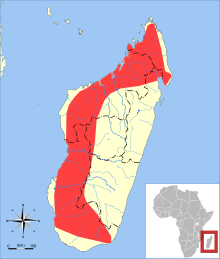Triaenops menamena
| Triaenops menamena | |
|---|---|
 |
|
| Skull of Triaenops menamena | |
| Scientific classification | |
| Kingdom: | Animalia |
| Phylum: | Chordata |
| Class: | Mammalia |
| Order: | Chiroptera |
| Family: | Rhinonycteridae |
| Genus: | Triaenops |
| Species: | T. menamena |
| Binomial name | |
|
Triaenops menamena Goodman and Ranivo, 2009 |
|
 |
|
| Distribution of Triaenops menamena (in green) and other species of Triaenops | |
 |
|
| Triaenops menamena range | |
Triaenops menamena is a bat in the genus Triaenops found on Madagascar, mainly in the drier regions. It was known as Triaenops rufus until 2009, when it was discovered that that name had been incorrectly applied to the species. Triaenops rufus is a synonym of Triaenops persicus, a Middle Eastern species closely related to T. menamena— the Malagasy species had previously been placed as a subspecies of T. persicus by some authors. Triaenops menamena is mostly found in forests, but also occurs in other habitats. It often roosts in large colonies and eats insects such as butterflies and moths. Because of its wide range, common occurrence, and tolerance of habitat degradation, it is not considered to be threatened.
With a forearm length of 50 to 56 mm (2.0 to 2.2 in) in males and 46 to 53 mm (1.8 to 2.1 in) in females, this is a medium-sized bat. Its fur color is variable, ranging from reddish brown to gray, but it is generally darker than the species in the closely related genus Paratriaenops which also occur on Madagascar. The skull contains a pronounced swelling around the nose and the second upper premolar is displaced outside the toothrow. The maximum frequency of the echolocation call averages 94.2 kHz and the species can easily be recognized on the basis of its call.
In 1881, Alphonse Milne-Edwards described two new species in the genus Triaenops on the basis of specimens supposedly collected by Léon Humblot on Madagascar: the reddish Triaenops rufus and the larger, gray T. humbloti.Jean Dorst, who reviewed Madagascan Triaenops in 1947, retained both as separate species; in another review, published in 1982, John Edwards Hill considered the two to represent the same species. In 1994, Karl Koopman considered rufus itself to be part of the Middle Eastern and mainland African species Triaenops persicus, a possibility Hill had discussed, but most authors regarded the two as distinct species. In 2006, Julie Ranivo and Steven Goodman revised Madagascan Triaenops and found little variation among specimens of T. rufus from throughout the dry parts of the island. Three years later, they published another paper which showed that the original material of T. rufus and T. humbloti was distinct from Madagascan specimens identified as "Triaenops rufus" and more similar to T. persicus. On his journey to Madagascar, Humblot had stayed in Somalia and Yemen, and Goodman and Ranivo concluded that he had probably collected the Triaenops there, after which their provenance was incorrectly recorded. Thus, rufus and humbloti cannot be used for the Madagascan species, and Goodman and Ranivo proposed the new name Triaenops menamena for the species formerly known as T. rufus. The specific name menamena is Malagasy for "reddish", referring to the animal's coloration. "Rufous trident bat" has been used as a common name for Triaenops rufus.
...
Wikipedia

